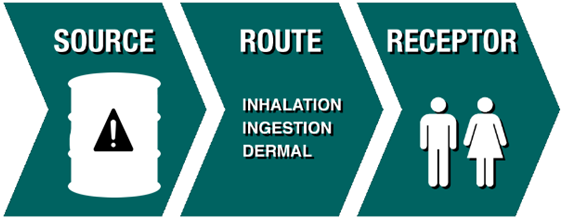What Is An Exposure?
An exposure happens when a chemical, pathogen, or contaminant gets into the body. We can also be exposed to physical hazards, such as noise and heat. Exposure can happen by eating, drinking, breathing, feeling, experiencing, or touching something hazardous. These environmental chemicals, hazards, or substances can be naturally occurring or man-made.
How Do Exposures Occur?

We can understand how exposures occur by looking at exposure pathways. An exposure pathway is how a substance gets from the environment into the human body. The most common exposure pathways are eating or drinking (ingestion), breathing (inhalation), or skin contact (dermal). Learn more about the most common exposure pathways below.
Route - Inhalation (breathing)
Hazardous substances can be in the form of particles, gases, or vapors. These gases or vapors can enter the body when we breathe.
Route - Ingestion (eating or drinking)
Hazardous substances can get into your body when you eat something contaminated with that substance. This could happen if you eat a vegetable grown in contaminated soil, if you eat meat or other products from an animal or fish that ate something hazardous, or by touching contaminated dirt or surfaces, not washing your hands after handling certain materials, and then touching your food or your mouth. People can also be exposed by drinking or cooking with water that has been contaminated.
Route - Dermal (touching)
Some substances in the soil, air or water can be absorbed through the skin. This could happen when gardening or digging in the dirt, swimming, or while showering and bathing. A person can also be exposed to physical hazards dermally, such as heat. Being exposed to higher temperatures can be felt by the heat receptors in our skin.
How Is Exposure Measured?
Exposure assessments are used to measure or estimate the amount of an outside substance a person has in their body and determine if having that substance in their body could make them sick. Not all exposures require an exposure assessment.
The way we measure or “assess” exposure depends on many factors:
- Sometimes it is easier to measure a substance in the environment than in a person and estimate the amount the person is exposed to.
- Other times, scientists can directly measure a substance in the body, usually by taking samples of blood, urine, hair, or other body tissues.
- When scientists can’t measure the substance itself inside the body or in the environment, they use biomarkers instead. Biomarkers provide evidence that a substance has been in the body. A biomarker can be measured in blood, urine, or other body tissues, and is a measurement of changes caused by the substance a person is exposed to.
How Do Exposures Affect Our Health?
Just because you are exposed to something does not necessarily mean your health will be affected. In fact, many things can change the way an exposure could affect a person’s health. For example:
- The type of substance
- The way the substance enters the body (e.g. eating, drinking, or breathing)
- The amount of substance that enters the body
- The amount or concentration of the substance in the environment
- The number of times and for how long a person is exposed
- The age of a person when they are exposed
- The health of a person when they are exposed
- The genetic makeup of the exposed person
- Other substances that a person is exposed to at the same time
That being said, environmental exposures are associated with many different diseases, including cancer, heart attack, heat stroke, and more. See our Health and Environment pages for a list of the diseases and environmental exposures we track.